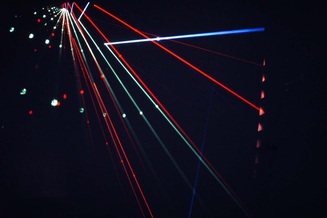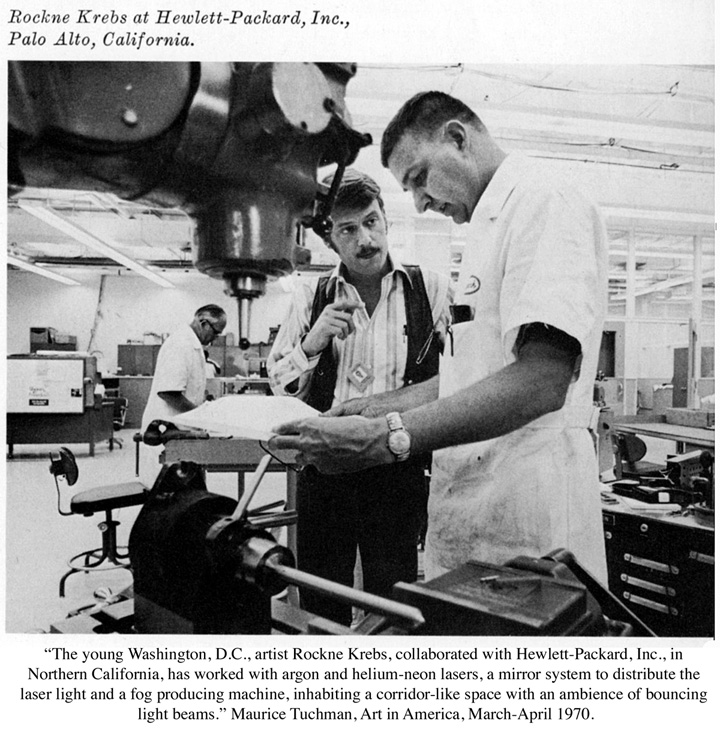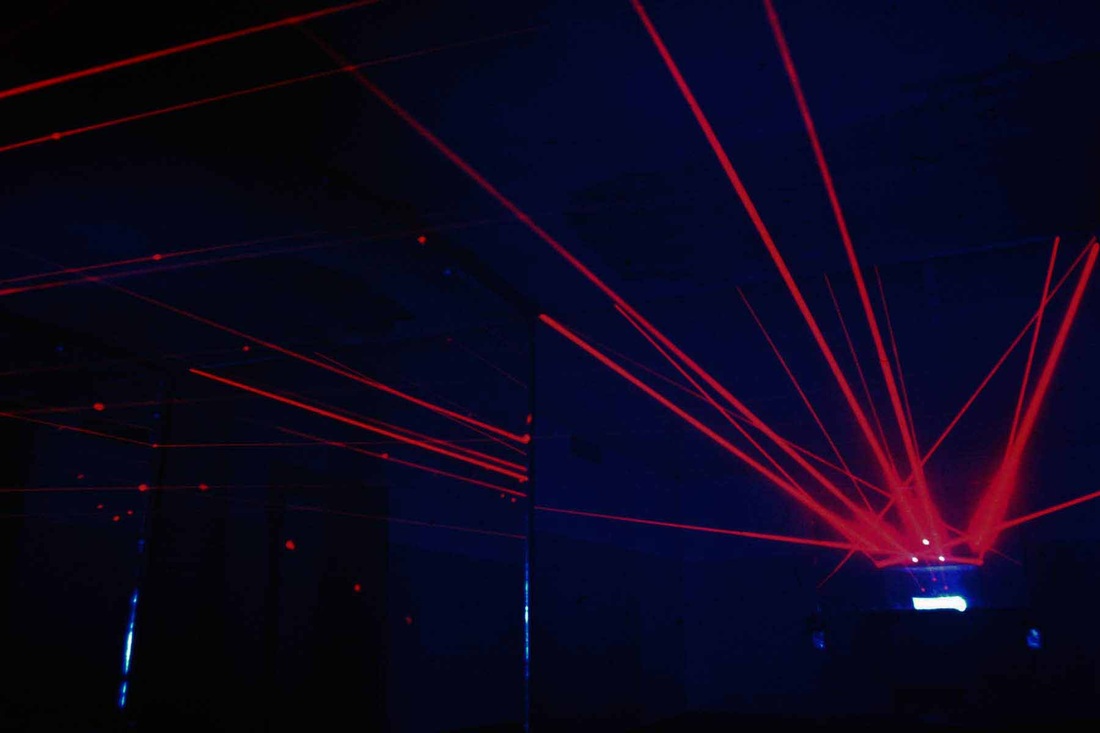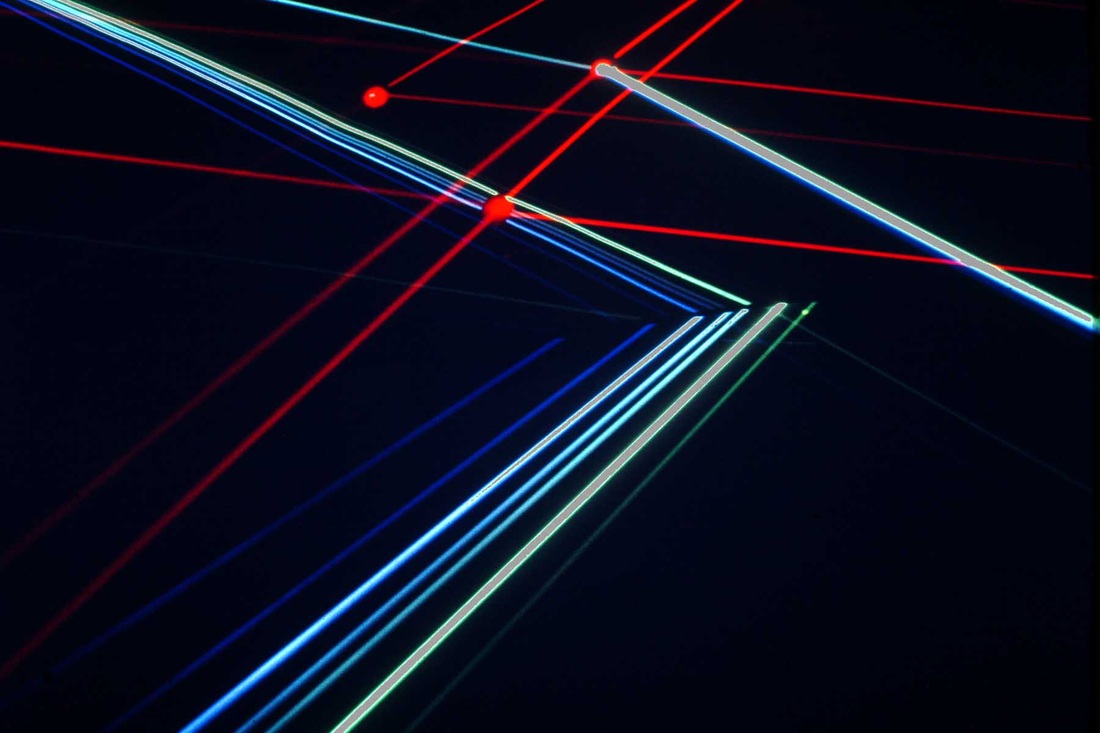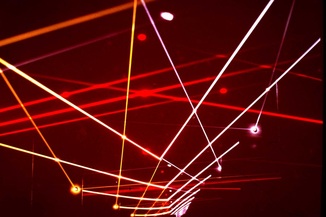Installations
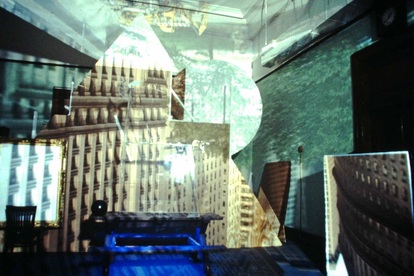
The Equestrian in Manhattan, 1977
“The Equestrian in Manhattan, Krebs's latest camera-obscura piece, was a complex arrangement of diverse, loosely associated objects and images fraught with spatial and symbolic ambiguities that presented a perceptual conundrum and an open field for interpretation…
Krebs appropriated for this piece an ideal site for public sculpture - Downtown Manhattan's Bowling Green - and optically brought it indoors…spreading a cinematic panorama, in varying degrees of distortion, over walls, floor and ceiling. The ceiling, in addition to an inverted projection, received a right-side - up reflection from a mirror placed at an angle beneath the lens, collaging blue sky and building tops upon upside-down pedestrians moving along the pavement. Talcum powder clouds sprayed on the carpeting mimicked images of their natural counterparts floating overhead…
This optical extravaganza was, however, only part of the piece. It also served as a stage set for a sculpture that gave the work its name: a Cubist-inspired, transparent plexiglass riderless horse, perched on a wooden picnic table illuminated from beneath by black light. The plexiglass permitted light to pass directly through the horse, causing no disruption to the images projected onto the structures behind. Standing 8 ½ feet high on the table-base (the legs of which are finished with carved hoofs), and with one "toe" (as Krebs calls it in his notes) poised Gattamelata-like on a bowling ball, the horse has a plexiglass pinwheel head and chrome tail; this doubles as the crank for an old Victrola which kept playing Red River Dave's rendition of "Home on the Range."
To elucidate the full range of ironic visual metaphors and dualities of The Equestrian would require more space than is available here. My own initial response was one of sensory bombardment- a feeling of being unable to sort out and account for the welter of information contained in this chaotic "landscape." Having identified
its elements, how does one construe such things as the formally apt, symbolically absurd substitution of a cannon ball by a bowling ball? ls it simply a pun on the Bowling Green location? What of the artist's invoking Monet and Donatello? Does the pin-wheel allude to Don Quixote? Where is the equestrian? And so forth. Gradually, a mock heroic eloquence settled on the piece, which began to read as a wry commentary on the increasing obsolescence of certain traditional forms of art - sculpture in particular-in today's world.”
McFadden, Sarah. Art in America, November-December 1977, New York Reviews, Rockne Krebs at the Custom House, pp. 133-134.
Krebs appropriated for this piece an ideal site for public sculpture - Downtown Manhattan's Bowling Green - and optically brought it indoors…spreading a cinematic panorama, in varying degrees of distortion, over walls, floor and ceiling. The ceiling, in addition to an inverted projection, received a right-side - up reflection from a mirror placed at an angle beneath the lens, collaging blue sky and building tops upon upside-down pedestrians moving along the pavement. Talcum powder clouds sprayed on the carpeting mimicked images of their natural counterparts floating overhead…
This optical extravaganza was, however, only part of the piece. It also served as a stage set for a sculpture that gave the work its name: a Cubist-inspired, transparent plexiglass riderless horse, perched on a wooden picnic table illuminated from beneath by black light. The plexiglass permitted light to pass directly through the horse, causing no disruption to the images projected onto the structures behind. Standing 8 ½ feet high on the table-base (the legs of which are finished with carved hoofs), and with one "toe" (as Krebs calls it in his notes) poised Gattamelata-like on a bowling ball, the horse has a plexiglass pinwheel head and chrome tail; this doubles as the crank for an old Victrola which kept playing Red River Dave's rendition of "Home on the Range."
To elucidate the full range of ironic visual metaphors and dualities of The Equestrian would require more space than is available here. My own initial response was one of sensory bombardment- a feeling of being unable to sort out and account for the welter of information contained in this chaotic "landscape." Having identified
its elements, how does one construe such things as the formally apt, symbolically absurd substitution of a cannon ball by a bowling ball? ls it simply a pun on the Bowling Green location? What of the artist's invoking Monet and Donatello? Does the pin-wheel allude to Don Quixote? Where is the equestrian? And so forth. Gradually, a mock heroic eloquence settled on the piece, which began to read as a wry commentary on the increasing obsolescence of certain traditional forms of art - sculpture in particular-in today's world.”
McFadden, Sarah. Art in America, November-December 1977, New York Reviews, Rockne Krebs at the Custom House, pp. 133-134.
|
U.S. Pavilion, Expo ’70, Osaka, Japan, 1970. The first ever laser beam switching system and prototype of the first laser light show, Krebs’ collaboration with Hewlett Packard Corporation. |
New Arts, Los Angeles County Museum of Art, in Osaka, Japan. “New Arts: In a completely enclosed area in the United States Pavilion stand the results of a pioneer experiment in which industrial corporations sheltered artists in residence and gave them the opportunity to explore advanced technology and transmute it into art.” United States Pavilion Japan World Exposition Osaka 1970, exhibition catalog. |
|
Cut Flowers, 1970, Washington: Twenty Years, Baltimore Museum of Art, Baltimore, MD.
“Krebs’ Cut Flowers, a laser piece exhibited this year at the Baltimore Museum of Art, was named for the four students who died at Kent State.” Richard, Paul. Washington Post, 1970 |
Day Passage, interior piece, 1971, exhibition Rockne Krebs, Day Passage and Night Passage, Albright-Knox Art Gallery, Buffalo, New York.
|
|
"Also existing in time as well as space is a 100-foot long laser beam-filled corridor, designed by
Rockne Krebs with Hewlett-Packard. The result is an absolutely hypnotic experience with intimations of infinity.” Seldis, Henry J. Los Angeles Times, May 16, 1971, County Museum Exhibit Mates Art and Technology. Day Passage, interior piece, 1971.
Art and Technology Exhibition, Los Angeles County Museum of Art, Los Angeles, CA. |
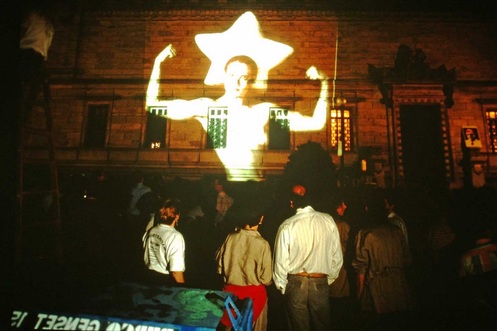
©Estate of Rockne Krebs/Licensed by VAGA, NY, NY.
Editors. ARTFORUM, September 1989, Mapplethorpe
Projections on the Corcoran Gallery of Art. Cover photo of Krebs’ Mapplethorpe projections on the Corcoran Gallery of Art, Washington, D.C. Cover: "Frank Herrara's photograph shows Robert Mapplethorpe's 'Self-Portrait with Cigarette,' 1980 as projected by laser artist Rockne Krebs on the facade of the Corcoran Gallery of Art, Washington D.C., on June 30, 1989, as part of a demonstration protesting the museum's cancellation of the Mapplethorpe retrospective that had been scheduled to open there that evening. The Demonstration - against the Corcoran's action specifically, and against censorship in the arts in general - was organized by William Wooby, of the Collector Gallery and Restaurant in Washington, and by Krebs, founder of the coalition of Washington Artists." - ARTFORUM Editor's description of cover.
A Robert Mapplethorpe self-portrait projected on the museum’s wall. “Laser Artist Rockne Krebs projected a huge, ghostly image of the dead artist on the stately façade of the building.” Newsweek, October 9, 1989, Corcoran Showdown.
Projections on the Corcoran Gallery of Art. Cover photo of Krebs’ Mapplethorpe projections on the Corcoran Gallery of Art, Washington, D.C. Cover: "Frank Herrara's photograph shows Robert Mapplethorpe's 'Self-Portrait with Cigarette,' 1980 as projected by laser artist Rockne Krebs on the facade of the Corcoran Gallery of Art, Washington D.C., on June 30, 1989, as part of a demonstration protesting the museum's cancellation of the Mapplethorpe retrospective that had been scheduled to open there that evening. The Demonstration - against the Corcoran's action specifically, and against censorship in the arts in general - was organized by William Wooby, of the Collector Gallery and Restaurant in Washington, and by Krebs, founder of the coalition of Washington Artists." - ARTFORUM Editor's description of cover.
A Robert Mapplethorpe self-portrait projected on the museum’s wall. “Laser Artist Rockne Krebs projected a huge, ghostly image of the dead artist on the stately façade of the building.” Newsweek, October 9, 1989, Corcoran Showdown.
